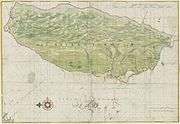Antonius Hambroek
| Antonius Hambroek | |
|---|---|
 | |
| Born |
1607 Rotterdam, Dutch Republic |
| Died |
July 21, 1661 Taiwan |
| Residence |
Netherlands Taiwan |
| Nationality | Dutch |
Antonius Hambroek (1607 – 21 July 1661) was a Dutch missionary to Formosa from 1648 to 1661[1] during the Dutch colonial era. He was martyred by Koxinga as the Chinese-Japanese warlord wrested Taiwan from the Dutch.[2] Koxinga had captured Hambroek along with his wife and three of his children, and sent him as a messenger to Frederik Coyett, the Governor of Formosa, to demand the surrender of the Dutch garrison at Fort Zeelandia and the abandonment of their colony. Koxinga promised the missionary death should he return with a displeasing answer; Coyett refused to surrender and Hambroek was executed on his return to Koxinga's camp.[3]
After the Siege of Fort Zeelandia, Koxinga took Hambroek's teenage daughter as a concubine.[4][5] Other Dutch women were sold to Chinese soldiers to become their wives.[6]
Antonius Hambroek, or the Siege of Formosa

The playwright Joannes Nomsz wrote a tragedy for the stage in 1775 about the martyrdom of Hambroek, "Antonius Hambroek, of de Belegering van Formoza" rendered in English as "Antonius Hambroek, or the Siege of Formosa",[7][8] sealing the missionary's fame in Holland.
The topic of the Chinese taking the Dutch women and the daughter of Antonius Hambroek as concubines was featured in Joannes Nomsz's play which became famous and well known in Europe which revealed European anxiety at the fate of the Dutch women and being subjected to defeat by non-Europeans.[9]
References
- ↑ Andrade, Tonio (2005). "Appendix B". How Taiwan Became Chinese: Dutch, Spanish, and Han Colonization in the Seventeenth Century. Columbia University Press.
- ↑ Asia in the Making of Europe. Book 2, South Asia. p. 279. ISBN 978-0-226-46765-8.
- ↑ "Nieuw Nederlandsch biografisch woordenboek (New Dutch Biographical Dictionary)" (in Dutch). Retrieved 2008-12-18.
- ↑ Samuel H. Moffett (1998). A History of Christianity in Asia: 1500-1900. VOLUME II (2, illustrated ed.). Orbis Books. p. 222. ISBN 1-57075-450-0. Retrieved Dec 20, 2011.(Volume 2 of A History of Christianity in Asia, Samuel H. Moffett Volume 36 of American Society of Missiology series)
- ↑ Free China review, Volume 11. W.Y. Tsao. 1961. p. 54. Retrieved Dec 20, 2011.
- ↑ Jonathan Manthorpe (2008). Forbidden Nation: A History of Taiwan (illustrated ed.). Macmillan. p. 77. ISBN 0-230-61424-8. Retrieved Dec 20, 2011.
- ↑ Nomsz, Joannes (1775). "Antonius Hambroek, of de Belegering van Formoza". Universiteit Leiden. AMSTELDAM: IZAAK DUIM, op den Cingel, tusschen de Warmoesgracht, en de Drie-Koningstraat.
- ↑ Andrade, Tonio (2011). Lost Colony: The Untold Story of China's First Great Victory Over the West. Princeton University Press. p. 5. ISBN 0691144559. Archived from the original on December 10, 2014. Retrieved December 10, 2014.
- ↑ Ernie (June 1, 2012). "Koxinga the Pirate". China Expat.

